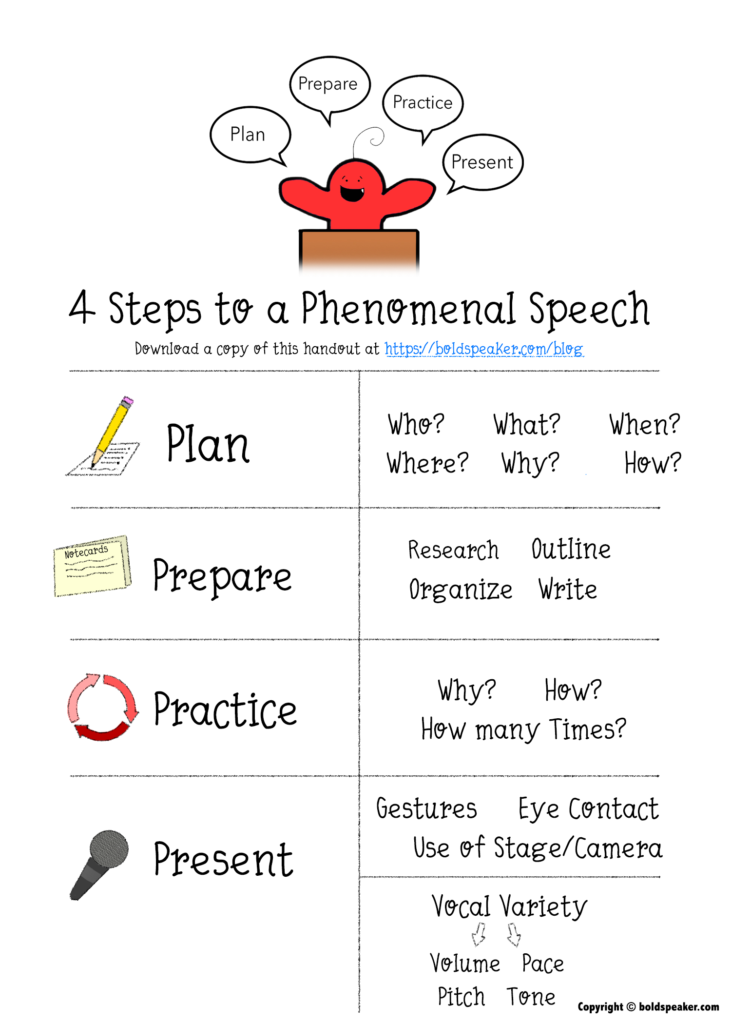Many people have asked me how to give a successful speech. While there is no one correct answer to this question, there are quite a few techniques to ensure that your speech goes smoothly. Today, we will be looking at one such technique that can help you give a successful speech. This technique is the 4 P’s Method.
As you might be able to tell from the name, the 4 P’s Method consists of 4 main steps: Plan, Prepare, Practice, and Present. Let’s now talk about how you would use these 4 steps for your next speech or presentation:
- Plan. First, ask yourself these 6 questions: the Who, What, Why, When, Where, How of your speech. What do I mean by that? Think how you would respond to the following questions:
- Who is the audience? What do they expect?
- What is the topic?
- Why am I speaking? Or what is the objective of my speech?
- When: what day or time am I speaking?
- Where am I speaking? In a classroom? A meeting room? A large conference room?
- How am I delivering this speech? Online or in person? Pre-recorded or live?
2. Prepare. To prepare for your speech, the first step is doing some research. This may involve looking up websites, listening to videos and podcasts, reading magazines, newspaper articles and books to find content you can use in your speech. Next, you need to understand the structure of your speech (Introduction, Body and Conclusion), Third, write the entire speech out (yes, this is necessary, but you definitely don’t have to write the entire thing out per se on paper – try using a google doc or other document-writing tool such as “Dictation” or “Voice Typing” if you do not feel like typing the entire speech out. When you do have it typed out, you get more ideas and have the opportunity to make revisions, it will be much more convenient to make these changes, too), and prepare your notecards.
Important note: If you are going to present your speech via Google Slides or Powerpoint or another online presentation tool, make sure not to write your entire speech out in the slides that you present. Never do this, as:
- Your slides will look cluttered
- It is a pain for the audience to decide between reading your slides or pay attention to what you are saying and
- It is just another step that you have to do which does not help you during your presentation.
Instead, write your speech out separately, and then, if you like, add some key points on to a few slides and present that as you speak. Your audience – whether you are presenting to your class or people you don’t know – will thank you!
Another useful but optional step in preparation is to create notecards to help you jog your memory of the points to make during your speech. A similar approach as I described above for slides applies to notecards too- don’t write the entire speech onto your notecards! It will tempt you to just read off of them, and even though the audience won’t be following along as you talk if you use them, they will still be a lot less engaged as your entire attention will go to reading off of the notecards.
3. Practice. Practice is not only necessary to a successful speech, but it also reduces anxiety-making it easier on you. Ideally, one should practice until they get the hang of their speech- which is usually around 10-15 times. You can practice in front of a mirror, in front of your friends, in front of stuffed animals and pets, in your head, in the car- you can practice pretty much anywhere! If you dare, you can even practice in front of your parents!
4. Present. When you present, try to keep some key points in mind: make eye contact with your audience (but try not to stare them down), take advantage of the stage/the space around the camera, make plenty of appropriately-timed gestures, and use vocal variety. Also, try not to fidget as much as possible. (For more tips, try referring to our other ebook or blog posts!)
So that’s all there is to it! Now, you understand the secret formula 🙂 and give a successful speech! In order to just remember the 4 P’s (who remembers them?): Plan, Prepare, Practice, and Present.
To make it easier to plan your speech and understand all the steps, we have included a handy-dandy PDF handout that you can print out and refer to whenever you need it.






1 thought on “Four Steps to a Successful Speech”
Good suggestion